15 Oct 2014
Should I Try Medications For Alcoholism?
There has long been a prevalent philosophy of addiction treatment that includes total abstinence. Of course it makes sense for an alcoholic to abstain totally from drinking, but some also say you should avoid drugs wherever you can, including medications. Ideas are changing, though, thanks to research.
We now know much more about addiction and its effect on the brain than ever before. Researchers have developed medications that may be able to help you recover more effectively and stay sober more easily. Not all agree that drugs are the way to go, so what should you do?
What To Do When Deciding Whether Or Not To Try Medications For Alcoholism:
Read Up On Drugs For Treating Alcoholism
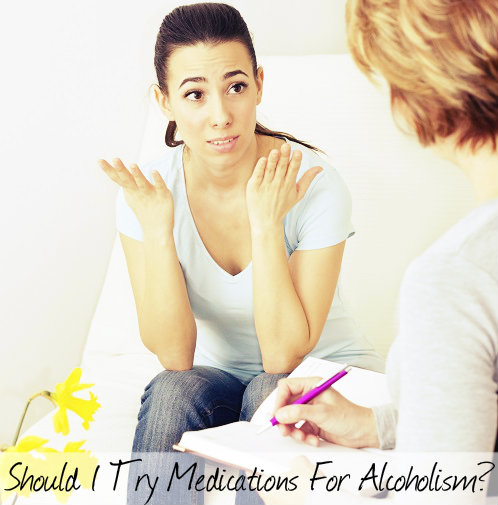 The first and best thing you can do when it comes to making a choice about medications is to read and learn. Knowledge is power, so read up on the drugs available to treat alcoholism and learn more about each one. Armed with the information, you can make a better choice and have a more intelligent discussion with your doctor and therapist.
The first and best thing you can do when it comes to making a choice about medications is to read and learn. Knowledge is power, so read up on the drugs available to treat alcoholism and learn more about each one. Armed with the information, you can make a better choice and have a more intelligent discussion with your doctor and therapist.
3 Common Alcoholism Treatment Drugs
Here is some introductory information to get you started learning about three of the most common drugs:
- Antabuse – The generic name for this drug is disulfram, and it has been around for decades helping alcoholics stop drinking. If you take the medication as directed and try to drink, you will get very sick. Symptoms are short-lived and include nausea, vomiting and headaches.
- Naltrexone – Naltrexone blocks the high, or pleasant feeling, that you normally get when drinking alcohol. If you take it as directed, you will have no reason to drink.
- Acamprosate – This is one of the newer drugs on the market for alcoholics and it works by helping you to resist the urge to relapse. You are only supposed to take this medication after you have given up drinking. It reduces some of the long-term withdrawal symptoms that would make you turn back to drinking.
Discuss Treatment Medications With Your Doctor And Therapist
You should always discuss your treatment plans with those experts you trust to your care. Of course your doctor will be the one to prescribe a medication, or your psychiatrist if you have one. Discuss the pros and cons with both your prescribing doctor and your therapist or drug counselor. These professionals can help you make an informed decision about whether alcoholism medications are right for you.
The most effective addiction treatment plan is one that is tailored to your specific needs. You, along with the professionals who know you and your history, are best qualified to develop a plan, whether or not it includes medications.
Never Rely Solely On Medication To Overcome Your Addiction
If you decide to give one or more of these medications a try, keep in mind that none of them is designed to be used alone. All are approved to treat alcoholism in conjunction with psychosocial therapy. This means that you need to use other treatment methods, including behavioral therapy, psychotherapy and support groups together with drugs for effectiveness. Drugs alone are not the answer because there is no simple cure for alcoholism or any other type of addiction.
The ultimate choice as to whether or not you try drugs to treat your addiction is up to you. In order to make the best choice for yourself and your future, make sure you are educated about the options, discuss with your medical and counseling professionals and make medications just one part of an overall treatment plan. If you follow these steps and make the commitment to stick to your plan, you stand every chance of a successful recovery.
See Other Drug And Alcohol Rehab FAQ’s
11 Sep 2014
Should You Try A Rapid Detox?
If you have been struggling with addiction, especially addiction to opioids like heroin or narcotic painkillers, you know how hard it is to kick the habit. As soon as you try to stop using, terrible withdrawal symptoms begin. They can be so severe that you feel you have no choice but to go back to using just to find relief. For many addicts the idea of a rapid, or even an ultra-rapid, detox is appealing. The promise of relief from withdrawal and an accelerated period of detox are tempting. But should you do it? There are risks and the effectiveness of such methods is not fully known. Before you think about going through with it, know the facts.
What Is Rapid Detox?
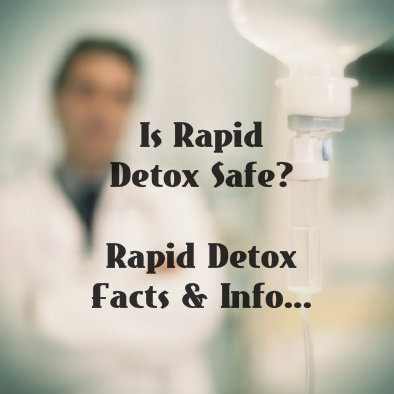 Rapid detox is an accelerated way of getting a drug out of your system. A physician or nurse who will give you a dose of an opioid agonist, such as naltrexone, typically conducts it. This is a drug that blocks the effect of any opioid still in your body. You will also be given some type of sedative so that as your body goes through withdrawal, you may feel little or none of it. In other words, you sleep through your withdrawal in relative comfort. Ultra rapid detox involves the intravenous delivery of naltrexone to make the process occur even more quickly.
Rapid detox is an accelerated way of getting a drug out of your system. A physician or nurse who will give you a dose of an opioid agonist, such as naltrexone, typically conducts it. This is a drug that blocks the effect of any opioid still in your body. You will also be given some type of sedative so that as your body goes through withdrawal, you may feel little or none of it. In other words, you sleep through your withdrawal in relative comfort. Ultra rapid detox involves the intravenous delivery of naltrexone to make the process occur even more quickly.
Does Rapid Detox Work?
Rapid detox does work in the sense that it clears your body of opioid drugs. However, simply not using the drugs anymore would achieve the same result. The real question is whether rapid or ultra-rapid detoxes work any better for long-term recovery than a natural detox process. A few studies of rapid detox have failed to find that the technique is any better for patients than a normal detox. In fact, they found that addicts undergoing rapid detox feel just as bad when they wake up from the process as those that were not given medications to minimize discomfort. Furthermore, the patients getting a rapid detox had similar long-term success rates as other addicts receiving the same post-detox treatment.
Is Rapid Detox Safe?
So far, rapid detox seems to be safe, but the same cannot yet be said for ultra-rapid detox. A few patients have suffered serious harm from the latter, and all had pre-existing conditions. The use of anesthesia during ultra-rapid detox can be dangerous for those with certain conditions, like AIDS, heart disease, hepatitis or diabetes.
Although it may feel like it at the time, withdrawal symptoms will not kill you. What can cause an addict to die is going back to drug use after a period of abstinence. By abstaining for a period of time you can lose some of your tolerance for an opioid drug. This means that if you relapse after detoxing you run an increased risk of accidentally overdosing. If you do not back up your rapid detox with further treatment, you will be more likely to relapse. Some people think that going through the detox will cure them of addiction and that they need no more treatment. This is a dangerous attitude.
Overall, the evidence is pointing to the fact that a rapid detox will not help you, but that it is safe if you have no pre-existing conditions and if you engage in long-term treatments for your addiction after a detox. It is wrong to believe that a rapid detox is the answer to your problems. You may want to use it as one tool in fighting your addiction, but it is not a cure.
Learn More About How Withdrawal Treatment And Detox Has Changed Over Time
Opioid maintenance treatment is a form of addiction treatment that uses opioid-based medications as safer substitutes for heroin or other powerful opioid substances of abuse. The two medications typically used in this kind of treatment are methadone and buprenorphine. In a study published in March 2014 in the journal Addiction, a multinational German and Swiss research team explored the potential usefulness of an opioid medication called slow-release oral morphine as an alternative to methadone in opioid maintenance treatment. These researchers concluded that slow-release oral morphine appears to be at least as effective as methadone in treating people with opioid use disorder.
Opioid Use Disorder And Medications
 People affected by opioid abuse or opioid addiction can receive a diagnosis for a condition officially known as opioid use disorder. Some addiction programs use opioid-based medications as temporary treatments for this disorder in order to help their patients/clients avoid the immediate pitfalls of opioid withdrawal. Others use opioid-based medications as longer-term alternatives for people affected by opioid use disorder.
People affected by opioid abuse or opioid addiction can receive a diagnosis for a condition officially known as opioid use disorder. Some addiction programs use opioid-based medications as temporary treatments for this disorder in order to help their patients/clients avoid the immediate pitfalls of opioid withdrawal. Others use opioid-based medications as longer-term alternatives for people affected by opioid use disorder.
Both methadone and buprenorphine produce their drug effects inside the brain more slowly than heroin and other commonly abused opioid substances. In addition, they have a lower maximum effect than the typical abused opioid. During opioid maintenance treatment, doctors rely on these characteristics to introduce either methadone or buprenorphine as an alternative to the unrestrained drug intake associated with unaddressed opioid addiction.
When used in this context, both medications allow addicted users to gain control over their drug intake while simultaneously evading the onset of severe opioid withdrawal. Methadone has a stronger opioid effect than buprenorphine and comes in the form of tablets or oral solutions. Buprenorphine is often combined with a second non-opioid medication called naloxone (which helps reduce any risks for buprenorphine abuse) and comes in the form of a tablet or strip placed under the tongue.
Slow-Release Oral Morphine
Morphine is one of the primary mind-altering substances found naturally in a plant called the opium poppy, which acts directly or indirectly as the originating source of all opioid drugs and medications. Pharmaceutical companies throughout the world manufacture purified forms of this substance as treatments for certain forms of mild and severe pain, including surgical pain and the pain associated with various forms of cancer.
Some forms of morphine pass rapidly to the brain after entering the bloodstream and have a relatively short-term impact on the ability to experience pain. Other forms are designed to pass into the brain slowly over an extended period of time and provide longer-term pain relief. Slow-release oral morphine, also known as extended-release morphine, is a specific type of long-acting morphine commonly prescribed for the treatment of significant pain that doctors expect to continue for prolonged amounts of time.
Slow-Release Oral Morphine’s Usefulness In Opioid Maintenance Treatment
In the study published in Addiction, researchers from six German institutions and one Swiss institution used a project involving 157 German and Swiss adults affected by opioid dependence/addiction to examine the usefulness of slow-release oral morphine in opioid maintenance treatment.
All of these individuals previously received methadone as part of their treatment; for a total of 22 weeks, some of the participants received slow-release oral morphine instead of methadone. The researchers monitored each individual’s continuing involvement in heroin use with two weekly urine drug tests and compared the results of the tests gathered from the methadone users to the results of the tests gathered from the slow-release morphine users.
After completing their comparisons, the researchers found that the slow-release morphine users were slightly more likely to test positive for heroin use during treatment than the methadone users. However, the difference between the two groups was minor and insignificant. The methadone users also had somewhat higher chances of remaining active participants in opioid maintenance treatment than the slow-release morphine users. However, the researchers again characterized the differences between the two groups as negligible. In addition, the group using slow-release morphine did not experience serious opioid-related harm during treatment any more often than the group using methadone.
Benefits Of Easier-Access Morphine For Opioid Maintenance Treatment
The authors of the study published in Addiction concluded that slow-release morphine is apparently just as useful in opioid maintenance treatment as methadone. This is important, in part, because federal guidelines restrict the places in which recovering addicts can receive methadone-based treatment. The authors note that the usefulness of slow-release morphine depends upon the amount of the medication used during opioid maintenance. As a rule, the number of heroin-positive urine tests drops as the amount of slow-release morphine given to a patient/client increases.
If You Or A Loved One Is Struggling With An Addiction…Don’t Give Up, Help Is Waiting – Call Us Now
18 Jun 2014
Abstinence In Addiction Recovery
The prevailing view in addiction treatment and recovery is that abstinence is the best approach. This means that once drugs or alcohol are removed from the body following detox, the addict resolves to totally abstain from using them. The reasoning behind this idea is that an addict is incapable of moderation. Many addicts in recovery believe that they have learned how to partake responsibly and that they can have a drink or two at a party. Is it really possible? Or do you need to abstain for the rest of your life?
Why Abstinence?
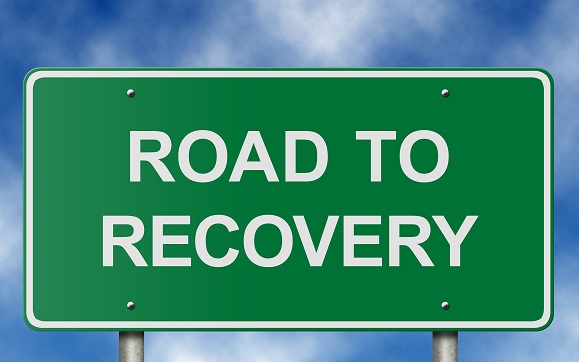 Abstinence as a philosophy for addiction treatment has been around for decades. Alcoholics Anonymous is one of the oldest support programs and is one that firmly believes in the importance of abstinence. Another model, similarly based on the 12 steps, is called the Minnesota Model and also calls for total abstinence from drugs and alcohol. For both programs, and any 12-step based program for addiction treatment, the primary goal is lifelong abstinence.
Abstinence as a philosophy for addiction treatment has been around for decades. Alcoholics Anonymous is one of the oldest support programs and is one that firmly believes in the importance of abstinence. Another model, similarly based on the 12 steps, is called the Minnesota Model and also calls for total abstinence from drugs and alcohol. For both programs, and any 12-step based program for addiction treatment, the primary goal is lifelong abstinence.
These addiction treatment programs advocate for abstinence because they believe it is the only way that an addict can return to a normal way of life. They claim that an addict in recovery cannot handle having just one drink, or using narcotic prescription painkillers. One small slip-up may lead to a downward spiral and a return to full-blown addiction.
Are There Any Non-Abstinence Treatment Options?
As addiction treatment advances and evolves, experts have developed models and programs that do not necessarily require abstinence. For example, harm reduction is a philosophy of treatment that is gaining ground. Long used for heroin addicts, harm reduction means taking steps to reduce risks and harm caused to addicts. It allows for addicts to reach sobriety on their own terms and in their own time. Heroin addicts being treated in this way are given maintenance drugs like methadone, or clean needles to reduce the risk of spreading infectious diseases such as HIV/AIDS, or hepatitis B and C.
Heroin addicts are not the only ones who are experimenting with non-abstinence. Other types of addicts are embracing the idea of moderation. Using alcohol moderately and responsibly is becoming more popular as a way for addicts to re-enter society as a contributing member. One such group advocating this approach, Moderation Management, believes in the possibility of changing behaviors without requiring total abstinence. In particular, they advocate for problem drinkers to learn how to become moderate drinkers.
Is Abstinence Best For Me?
Whether you need to embrace complete abstinence is a personal choice. Some people respond well to a non-abstinence-based approach. They can be successful at learning how to moderate drinking, how to drink socially and how to be responsible about drinking without taking a headfirst dive back into addiction. For others, however, this approach simply doesn’t work and complete abstinence is the only safe way to remain healthy and well.
Making the choice to embrace moderation is not a decision to make alone. If you are already in recovery, talk to your therapist, counselor, mentor, and your closest friends and family members. Getting treatment was not something you could do alone and making this choice isn’t either. If you decide to try drinking in moderation, make sure that the people who support you know about your choice and respect their opinions. If everyone says it’s a bad idea, listen. If you do try to drink and it causes a bad relapse, don’t feel bad. Just get back into your recovery routine, resume therapy sessions, if possible, and recommit to sobriety.
Learn More About 12 Step Treatment Programs – And Break Free From Addiction!
Contingency management is a form of behavioral psychotherapy known to help people recover from an addiction to the stimulant drug cocaine. This therapy uses vouchers or cash prizes to encourage recovering addicts to stay active in the treatment process and meet their program goals.
In a study published in June 2014 in the journal Drug and Alcohol Dependence, a team of researchers from Wayne State University investigated the question of whether the value of the reward offered during contingency management has an impact on the therapy’s chances of producing beneficial outcomes.
Cocaine Addiction Treatment
 People addicted to cocaine have a chemical dependence stemming from the lasting changes that the drug makes inside their brains, as well as symptoms that indicate a loss of control over use of the drug and/or a clearly damaging pattern of behavior centered on drug use. When doctors treat certain forms of substance addiction, they can rely on medications proven to increase the odds that a client/patient will halt substance use and establish long-term abstinence.
People addicted to cocaine have a chemical dependence stemming from the lasting changes that the drug makes inside their brains, as well as symptoms that indicate a loss of control over use of the drug and/or a clearly damaging pattern of behavior centered on drug use. When doctors treat certain forms of substance addiction, they can rely on medications proven to increase the odds that a client/patient will halt substance use and establish long-term abstinence.
However, although a number of medications show promise as potential treatments for cocaine addiction, doctors addressing this type of addiction do not currently have a reliable medication available for their use. This means that treatment programs for people addicted to the drug must use some form of counseling or psychotherapy to provide the needed assistance.
The form of psychotherapy most commonly employed for this purpose is behavioral therapy, a term that describes any therapeutic approach designed to modify and/or replace harmful behaviors that support continued involvement in substance use.
Contingency Management
Contingency management (CM) is one of the most frequently used forms of behavioral therapy. One approach to the therapy, called voucher-based reinforcement, provides clients/patients with valuable vouchers as rewards for doing such things as producing drug-free urine tests, regularly attending treatment program activities and otherwise taking the steps required to establish drug abstinence and maintain that abstinence.
Within limits, people enrolled in voucher-based programs can choose how to redeem their vouchers.
Another approach to CM, called prize incentives contingency management, substitutes cash prizes for vouchers. When a client or patient participating in this type of contingency management reaches a program objective, he or she earns the chance to enter a drawing and win varying amounts of cash.
As a rule, the rewards in both types of contingency management go up when a program participant consistently meets his or her treatment goals.
Does The Value Of The CM Reward Matter To Addicts?
The Wayne University researchers assessed the impact of the value of the reward offered on the odds that a recovering cocaine addict will comply with his or her program objectives and avoid cocaine use.
During the study, 15 cocaine addicts participated in 10 sessions that required them to choose between drug use and taking the steps required to receive a financial reward for program compliance. During some of these sessions, the reward offered was $1; other sessions offered a reward of $3 for avoidance of cocaine use. In addition, during some of the sessions, the participants had a chance of winning $6, $12 or $24.
The conditions of the first two types of sessions mimicked the terms of voucher-based contingency management, while the conditions of the third type of session mimicked the terms of prize incentives CM. Prior to the main phase of the study, the researchers made sure that the enrolled participants still viewed cocaine use as an attractive and tempting option.
After completing their testing, the researchers concluded that, during the contingency management sessions that offered a fixed $3 reward for not using cocaine, the study participants were substantially more likely to avoid taking the drug than they were during the contingency management sessions that offered a $1 reward.
They also found that the same results held true when the study participants had to choose between using cocaine and taking a chance at winning $6, $12 or $24.
Are Both Alternative Addiction Treatment Programs Effective?
The results of the study generally confirmed the effectiveness of both voucher-based CM and prize incentives CM as methods for helping recovering cocaine addicts remain drug-abstinent.
The study’s authors also concluded that the chances that both of these approaches to contingency management will produce the desired benefits go up when the amount of the reward for avoiding drug use is relatively high.
Methadone maintenance treatment and abstinence-based treatment are two approaches used in recovery programs for people affected by opioid addiction. When successful, each of these treatment options helps opioid addicts reduce their level of craving for continued drug/medication use.
In a study published March/April 2014 in the Journal of Addiction Medicine, a multinational team of researchers compared the brain effects of successful methadone maintenance treatment to the brain effects of successful abstinence-based treatment. These researchers concluded that each of the two approaches to opioid addiction treatment has its own unique impact on brain function.
 Harm Reduction
Harm Reduction
Methadone maintenance treatment is one form of a harm reduction-based approach to substance addiction. In harm reduction, doctors don’t set complete abstinence from substance intake as a necessary goal of treatment.
Instead, they attempt to limit the damage caused by uncontrolled substance use, even if this means that their patients still engage in substance use to a lesser degree or in more strictly limited circumstances.
An opioid addict participating in methadone maintenance receives a specific amount of methadone (an opioid medication) every day instead of consuming an unknown or unpredictable amount of heroin or some other powerful opioid drug of abuse. This dose of methadone provides enough of an opioid effect to avoid triggering symptoms of withdrawal i
Abstinence-Based Treatment For Opioid Addiction
An abstinence-based approach to opioid addiction treatment may also involve the use of methadone or another opioid medication called buprenorphine as a temporary treatment to help recovering addicts avoid the worst symptoms of opioid withdrawal.
However, the ultimate aim of this approach is to help recovering addicts completely avoid opioid use on an ongoing basis. This means that the use of opioid medications is strictly limited, if it occurs at all. Abstinence-based programs may also use non-opioid-based medications such as naloxone or naltrexone, which actively block the drug effects of opioid substances in patients/clients who have completely detoxified from active opioid use.
Counseling And Psychotherapy Treatment Sessions
Both methadone maintenance and abstinence-based programs also typically use some form of counseling, psychotherapy or mutual support to augment the effects of medication and improve the odds that treatment will have a beneficial outcome.
Forms of counseling and psychotherapy used in opioid addiction treatment include a behavioral retraining approach called cognitive behavioral therapy and a modern-day form of psychoanalysis called psychodynamic therapy. Many mutual support groups for recovering opioid addicts follow a basic 12-step approach that emphasizes ongoing drug abstinence.
Differing Brain Effects For Methadone vs. Abstinence-Based Treatment
In the study published in the Journal of Addiction Medicine, researchers from Australia and Iran used an imaging technology called fMRI (functional magnetic resonance imaging) to compare the brain functions of a group of people who successfully participated in methadone maintenance treatment for heroin addiction to the brain functions of a group of people who successfully participated in abstinence-based treatment for heroin addiction.
For comparison’s sake, they also examined the brain functions of a third group of people unaffected by opioid addiction. The fMRI scans were taken while the members of all three groups viewed a mixture of stimulating cues, including cues designed to trigger any residual cravings for heroin. In addition to analyzing the data from these scans, the researchers asked each individual to report his or her level of drug craving prior to and after exposure to the heroin-related cues.
The researchers found that the members of the methadone maintenance group and the members of the abstinence-based treatment group displayed an equal ability to resist the heroin cues used during the fMRI scans. However, they concluded that different brain areas were activated in each group as a result of exposure to the cues.
Compared to people unaffected by opioid addiction, the people who participated in methadone maintenance showed an unusually high level of activity in parts of the brain responsible for visual processing, logical analysis, the control of both pleasure- and fear-based emotional responses, and basic muscle coordination.
On the other hand, the people who participated in abstinence-based treatment showed an unusually high level of activity in parts of the brain responsible for regulating decision-making, controlling impulsive behavior, anticipating rewards and controlling certain key involuntary functions in the cardiovascular (heart and blood vessel) system.
The authors of the study published in the Journal of Addiction Medicine note that, when successful, both methadone maintenance treatment and abstinence-based treatment are linked to increased activity in brain areas that help recovering opioid addicts significantly reduce their drug cravings. They also note the clearly differing brain pathways that are typically activated in participants in each type of treatment.
Discover Additional Treatments For Opioid Addiction Help Is Available – Call Now!
Naltrexone is a medication that directly counteracts the intoxicating effects of legal and illegal opioid narcotic substances. Doctors sometimes use the medication to treat people recovering from opioid addiction, but the success of this treatment depends largely on each individual taking his or her naltrexone dose on a regular basis.
In a study published in March/April 2014 in the American Journal on Addictions, a team of Chinese researchers explored the safety of a long-lasting, injectable form of naltrexone that could eliminate some of the concerns about maintaining regular dosing of the medication.
Naltrexone For Opioid Addiction Treatment
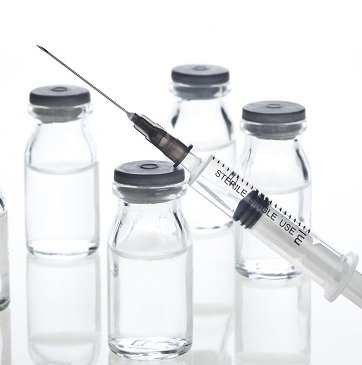 Scientists classify naltrexone with a group of substances known as opioid antagonists. When they enter the bloodstream, all of these substances travel to the sites that normally give opioid drugs and medications access to the brain. Once they reach these sites, opioid antagonists physically block opioids and prevent them from producing their narcotic effects.
Scientists classify naltrexone with a group of substances known as opioid antagonists. When they enter the bloodstream, all of these substances travel to the sites that normally give opioid drugs and medications access to the brain. Once they reach these sites, opioid antagonists physically block opioids and prevent them from producing their narcotic effects.
Naltrexone, in particular, can play a role in opioid addiction treatment because it blocks the effects of opioid substances, lowers the level of opioid craving in recovering addicts and helps diminish the chances that recovering opioid addicts will relapse.
Unlike two opioid-based medications—called methadone and buprenorphine—commonly used in opioid addiction treatment, naltrexone is not a controlled substance. This means that doctors and other qualified health professionals require no special licensing to prescribe it. Many health professionals prescribe an oral form of the medication that patients must take every day.
Injectable Naltrexone
Extended-release, injectable naltrexone is also known as depot naltrexone. Doctors or other qualified professionals administer this medication directly into muscle tissue (typically the gluteus muscles). Instead of dissipating in the bloodstream relatively rapidly like oral naltrexone, extended-release, injectable naltrexone gradually enters the bloodstream for roughly one month and blocks access to the effects of opioid drugs and medications throughout that time.
The main potential benefit of this form of naltrexone is improved compliance with the abstinence goals established in opioid addiction recovery programs. Like the short-acting oral version of the medication, depot naltrexone can trigger severe withdrawal symptoms if given to a recovering addict who still has opioids in his or her system.
For this reason, standard treatment guidelines stipulate that doctors wait at least a week after the verified end of opioid intake to administer the medication. The U.S. Food and Drug Administration approved the sale of an extended-release, injectable naltrexone product called Vivitrol in 2010.
Safety Of Injectable Naltrexone
In the study published in the American Journal on Addictions, researchers from three Chinese institutions used a small-scale trial to assess the safety of injectable depot naltrexone and examine patients’ ability to tolerate the medication.
All told, this trial included 36 people. Twenty-four of these individuals participated in a separate panel. Six people in this panel received a relatively high 400 mg dose of injectable naltrexone, while another six received a relatively low 200 mg dose of the medication. Twelve people in the panel received placebo injections that mimicked either the 400 mg naltrexone dose or the 200 mg naltrexone dose. The remaining 12 study participants were enrolled in a second panel and randomly received either six monthly 400 mg naltrexone injections or placebo injections that mimicked the naltrexone injections.
The researchers found that both the recipients of the 200 mg injections and the 400 mg injections still had medically significant amounts of naltrexone in their bloodstreams one month after dosing. Eleven of the people who received injectable naltrexone had some sort of adverse reaction while using the medication.
The researchers concluded that seven of these reactions were potentially the result of naltrexone exposure; however, they also concluded that none of the observed reactions produced moderate or severe effects.
Overdose Risks?
The authors of the study published in the American Journal on Addictions found that extended-release naltrexone injections deliver steady amounts of the medication for a minimum of one month. They also found that the medication does not accumulate dangerously after multiple monthly injections occur.
Overall, they concluded that extended-release, injectable naltrexone is tolerated well by patients and does not pose any undue safety risks.
On a related note, the federal Substance Abuse and Mental Health Services Administration points out that fatal or non-fatal opioid overdoses sometimes occur in people who receive monthly naltrexone injections but still continue taking opioid substances; however, the same overdose risks also apply to users of oral naltrexone or opioid-based treatment options.
If You Or Someone You Love Is Struggling With Addiction, Call Us Now! Help Is Waiting.
See Why Naltrexone Helps Reduce Amphetamine Use Could This Be An Effective Treatment For Your Addiction?
According to the Centers for Disease Control and Prevention, tobacco use is the leading preventable cause of death in the United States. This is why helping people quit smoking is such a priority. Unfortunately, most smokers find it very hard to give up the habit. The Smoking Treatment for Ontario Patients (STOP) program—funded by the Ontario Ministry of Health and Long-Term Care—is one approach that manages to increase quit-rates by providing nicotine patches and psychological treatment to smokers, and could serve as an example for U.S.-based organizations. The initiative started in 2005 and now runs numerous times per year, offering smokers the opportunity to break free of their addictions and get healthy.
Why Is It So Hard To Quit Smoking?
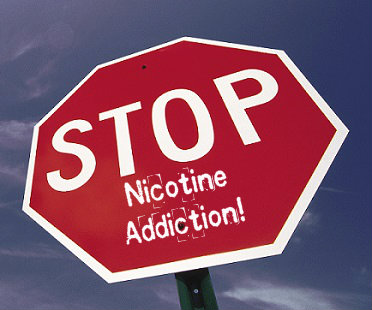 Although tobacco is a widespread and legal substance, quitting it is hard for many of the same reasons that it’s difficult to stop using illegal drugs. Nicotine—the addictive component of cigarettes—releases dopamine in the brain, the neurochemical responsible for the majority of addictions. When the body gets accustomed to it, the external “boost” that smoking provides stops, and this leads to an imbalance in brain chemicals followed by unpleasant symptoms. The problem is compounded by the fact that research indicates “cold turkey” (unsupported) quitting is the most popular method, but is a considerably less successful strategy than counseling, medications and nicotine replacement therapy (like gums or patches). In short, smokers—with an already difficult task ahead of them—often try to quit by themselves, which is statistically the least successful method.
Although tobacco is a widespread and legal substance, quitting it is hard for many of the same reasons that it’s difficult to stop using illegal drugs. Nicotine—the addictive component of cigarettes—releases dopamine in the brain, the neurochemical responsible for the majority of addictions. When the body gets accustomed to it, the external “boost” that smoking provides stops, and this leads to an imbalance in brain chemicals followed by unpleasant symptoms. The problem is compounded by the fact that research indicates “cold turkey” (unsupported) quitting is the most popular method, but is a considerably less successful strategy than counseling, medications and nicotine replacement therapy (like gums or patches). In short, smokers—with an already difficult task ahead of them—often try to quit by themselves, which is statistically the least successful method.
Physical Withdrawal Symptoms Of Nicotine Withdrawal
Like with other drugs, when you stop consuming nicotine you may feel a wide range of physical symptoms. The most common smoking withdrawal symptoms are agitation, irritability, weight gain, depression and anxiety. The negative symptoms come on because the individual is no longer getting the nicotine he’s become dependent on, and the brain knows it, creating cravings in an attempt to make the individual succumb to temptation and give it another hit of nicotine.
Psychological Challenges Of Quitting Smoking
Although the physical withdrawal symptoms add to the discomfort of quitting smoking, the psychological effects are what drive many ex-smokers to relapse. Smoking, like other drug addictions, is a poor coping strategy for dealing with everyday problems, and when these problems return, the individual is at particular risk for relapse. Both internal and external “triggers” to smoke can make the process more difficult, with internal factors including things like stress and depression and external ones including things like being around a friend who smokes or taking a work break that you previously used for smoking. These things push the individual back to smoking, and in combination with the physical withdrawal symptoms, they make the process of quitting extremely challenging.
Benefits Of Initiatives Like STOP
These issues are what make initiatives like STOP so worthwhile. The core selling point of STOP is that attendees receive five weeks’ worth of free nicotine patches, which ordinarily cost around $30 per week, meaning they save around $150. This removes what some see as a financial barrier to getting the support they need, but the support also takes the psychological elements into account. Each qualifying smoker is also eligible to attend workshops and receive ongoing support to help manage triggers and cravings.
This broad range of support contributes to the impressive success rates enjoyed by the initiative. Oxford County’s tobacco control coordinator Dominique Bruce points out that those in the program have a quit rate that’s 50 percent higher than those not in the program. She also points to the cost savings and psychological support offered by the program. “If you slip up, you need to remember it’s just a slip up, not a fail,” Bruce said.
The Right Way To Help People Quit Smoking
There are many lessons that can be learned from programs like STOP, and although this initiative is in Canada, U.S.-based stop smoking initiatives can take a cue from the approach and work to reduce the preventable diseases and deaths caused by smoking. The smokers themselves face the biggest challenges, but with the right support and the guidance to help them push through the difficult periods, they have the ability to kick their tobacco addiction for good. As long as we understand the challenges inherent in quitting smoking—or kicking any addiction—we can find the compassion to help those in need and the wisdom to do so in the most effective way possible.


